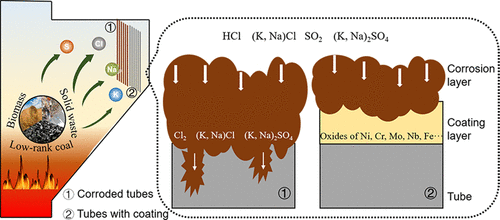当前位置:
X-MOL 学术
›
Energy Fuels
›
论文详情
Our official English website, www.x-mol.net, welcomes your feedback! (Note: you will need to create a separate account there.)
Application of Coatings to Alleviate Fireside Corrosion on Heat Transfer Tubes during the Combustion of Low-Grade Solid Fuels: A Review
Energy & Fuels ( IF 5.3 ) Pub Date : 2020-08-12 , DOI: 10.1021/acs.energyfuels.0c02145 Xiuju Zhang 1 , Huan Liu 1, 2 , Tongzhou Chen 3 , Geyi Wang 1, 2 , Haiyan Li 1 , Hongyun Hu 1 , Yun Yu 1 , Hong Yao 1
Energy & Fuels ( IF 5.3 ) Pub Date : 2020-08-12 , DOI: 10.1021/acs.energyfuels.0c02145 Xiuju Zhang 1 , Huan Liu 1, 2 , Tongzhou Chen 3 , Geyi Wang 1, 2 , Haiyan Li 1 , Hongyun Hu 1 , Yun Yu 1 , Hong Yao 1
Affiliation

|
To address the energy and environmental issues related to the use of traditional fossil fuels, the thermal utilization of low-grade solid fuels such as low-rank coal, biomass, and municipal solid waste has gradually attracted much attention. During the combustion of the low-grade solid fuels, one of the major operation problems is the fireside corrosion on heat transfer tubes, which easily causes the frequent replacement of tubes and shutdown of boilers, largely reducing the energy and economic performances. In this review, the causes and mechanisms of corrosion were first clarified to provide a basis for mitigating the losses induced by the fireside corrosion, followed by the introduction of the preparation and properties of coatings, which show great potential to resist the invasion of corrosive species by attaching the reinforced surface to the tubes. To demonstrate the feasibility of the coating for high-temperature corrosion resistance, 94 kinds of coatings in more than 60 literature contributions were statistically analyzed. It was found that over 90% of anticorrosion coatings were prepared from thermal spraying techniques, and approximately three-quarters of the anticorrosion coatings were made of NiCr-based alloys. Many methods were reported to evaluate the corrosion resistance of coatings in literature, including mass gain/loss method, ash deposition method, contact angle method, and ash adhesion method. As for exploring the anticorrosion mechanisms of coatings, it was found that the protection was achieved by the formation of dense oxide scale, such as Cr2O3, NiO, MoO2, and so on. Furthermore, the application status of coatings in power plants was also summarized. According to the pilot-scale tests listed in literature, the obvious similarity is that the adopted technologies were mainly High velocity oxy-fuel (HVOF) spraying or cold spraying techniques, with almost all of the coated materials being NiCr-based alloys as well as a small portion of Fe/Co-based alloys. This indicates that the NiCr-based coatings prepared by HVOF spraying technique have been widely applied in power plants. In order to promote the large-scale application of anticorrosion coatings, it is prospective to focus on several key research aspects: (1) predicting the corrosion conditions from fuel compositions, (2) developing cost-effective coatings, (3) establishing the systematic evaluation methods by laboratory tests, (4) achieving in-depth understanding of the anticorrosion mechanisms, and (5) conducting a comprehensive economic analysis.
中文翻译:

涂料在减轻低级固体燃料燃烧过程中减轻传热管炉边腐蚀的研究进展
为了解决与使用传统化石燃料有关的能源和环境问题,低等级煤,低等级煤,生物质和城市固体废物等低等级固体燃料的热利用已逐渐引起人们的关注。在低级固体燃料燃烧期间,主要的操作问题之一是传热管的炉膛腐蚀,这很容易引起换热管的频繁更换和锅炉的停机,从而大大降低了能源和经济性能。在这篇综述中,首先阐明了腐蚀的原因和机理,为减轻炉边腐蚀引起的损失提供了基础,然后介绍了涂料的制备和性能,通过将增强的表面附着到管子上,它们显示出巨大的潜力来抵抗腐蚀性物质的入侵。为了证明该涂料具有抗高温腐蚀的可行性,对60多种文献中的94种涂料进行了统计分析。已经发现,超过90%的防腐蚀涂层是通过热喷涂技术制备的,大约四分之三的防腐蚀涂层是由NiCr基合金制成的。文献中报道了许多评估涂层耐腐蚀性的方法,包括质量增减法,灰分沉积法,接触角法和灰分粘附法。关于探索涂层的防腐机理,发现保护是通过形成致密的氧化皮(如铬)来实现的。为了证明该涂料具有抗高温腐蚀的可行性,对60多种文献中的94种涂料进行了统计分析。已经发现,超过90%的防腐蚀涂层是通过热喷涂技术制备的,大约四分之三的防腐蚀涂层是由NiCr基合金制成的。文献中报道了许多评估涂层耐腐蚀性的方法,包括质量增减法,灰分沉积法,接触角法和灰分粘附法。关于探索涂层的防腐机理,发现保护是通过形成致密的氧化皮(如铬)来实现的。为了证明该涂料具有抗高温腐蚀的可行性,对60多种文献中的94种涂料进行了统计分析。已经发现,超过90%的防腐蚀涂层是通过热喷涂技术制备的,大约四分之三的防腐蚀涂层是由NiCr基合金制成的。文献中报道了许多评估涂层耐腐蚀性的方法,包括质量增减法,灰分沉积法,接触角法和灰分粘附法。关于探索涂层的防腐机理,发现保护是通过形成致密的氧化皮(如铬)来实现的。对60余种文献的94种涂料进行了统计分析。已经发现,超过90%的防腐蚀涂层是通过热喷涂技术制备的,大约四分之三的防腐蚀涂层是由NiCr基合金制成的。文献中报道了许多评估涂层耐腐蚀性的方法,包括质量增减法,灰分沉积法,接触角法和灰分粘附法。关于探索涂层的防腐机理,发现保护是通过形成致密的氧化皮(如铬)来实现的。对60余种文献的94种涂料进行了统计分析。已经发现,超过90%的防腐蚀涂层是通过热喷涂技术制备的,大约四分之三的防腐蚀涂层是由NiCr基合金制成的。文献中报道了许多评估涂层耐腐蚀性的方法,包括质量增减法,灰分沉积法,接触角法和灰分粘附法。关于探索涂层的防腐机理,发现保护是通过形成致密的氧化皮,例如铬来实现的。大约四分之三的防腐蚀涂层由NiCr基合金制成。文献中报道了许多评估涂层耐腐蚀性的方法,包括质量增减法,灰分沉积法,接触角法和灰分粘附法。关于探索涂层的防腐机理,发现保护是通过形成致密的氧化皮(如铬)来实现的。大约四分之三的防腐蚀涂层由NiCr基合金制成。文献中报道了许多评估涂层耐腐蚀性的方法,包括质量增减法,灰分沉积法,接触角法和灰分粘附法。关于探索涂层的防腐机理,发现保护是通过形成致密的氧化皮,例如铬来实现的。2 O 3,NiO,MoO 2, 等等。此外,还总结了涂料在电厂中的应用状况。根据文献中列出的中试规模测试,明显的相似之处是采用的技术主要是高速氧燃料(HVOF)喷涂或冷喷涂技术,几乎所有涂层材料都是NiCr基合金以及一小部分铁/钴基合金。这表明通过HVOF喷涂技术制备的NiCr基涂层已被广泛应用于发电厂。为了促进防腐涂料的大规模应用,有希望将重点放在几个关键的研究方面:(1)从燃料成分预测腐蚀条件;(2)开发具有成本效益的涂料;(3)建立系统通过实验室测试的评估方法,
更新日期:2020-10-16
中文翻译:

涂料在减轻低级固体燃料燃烧过程中减轻传热管炉边腐蚀的研究进展
为了解决与使用传统化石燃料有关的能源和环境问题,低等级煤,低等级煤,生物质和城市固体废物等低等级固体燃料的热利用已逐渐引起人们的关注。在低级固体燃料燃烧期间,主要的操作问题之一是传热管的炉膛腐蚀,这很容易引起换热管的频繁更换和锅炉的停机,从而大大降低了能源和经济性能。在这篇综述中,首先阐明了腐蚀的原因和机理,为减轻炉边腐蚀引起的损失提供了基础,然后介绍了涂料的制备和性能,通过将增强的表面附着到管子上,它们显示出巨大的潜力来抵抗腐蚀性物质的入侵。为了证明该涂料具有抗高温腐蚀的可行性,对60多种文献中的94种涂料进行了统计分析。已经发现,超过90%的防腐蚀涂层是通过热喷涂技术制备的,大约四分之三的防腐蚀涂层是由NiCr基合金制成的。文献中报道了许多评估涂层耐腐蚀性的方法,包括质量增减法,灰分沉积法,接触角法和灰分粘附法。关于探索涂层的防腐机理,发现保护是通过形成致密的氧化皮(如铬)来实现的。为了证明该涂料具有抗高温腐蚀的可行性,对60多种文献中的94种涂料进行了统计分析。已经发现,超过90%的防腐蚀涂层是通过热喷涂技术制备的,大约四分之三的防腐蚀涂层是由NiCr基合金制成的。文献中报道了许多评估涂层耐腐蚀性的方法,包括质量增减法,灰分沉积法,接触角法和灰分粘附法。关于探索涂层的防腐机理,发现保护是通过形成致密的氧化皮(如铬)来实现的。为了证明该涂料具有抗高温腐蚀的可行性,对60多种文献中的94种涂料进行了统计分析。已经发现,超过90%的防腐蚀涂层是通过热喷涂技术制备的,大约四分之三的防腐蚀涂层是由NiCr基合金制成的。文献中报道了许多评估涂层耐腐蚀性的方法,包括质量增减法,灰分沉积法,接触角法和灰分粘附法。关于探索涂层的防腐机理,发现保护是通过形成致密的氧化皮(如铬)来实现的。对60余种文献的94种涂料进行了统计分析。已经发现,超过90%的防腐蚀涂层是通过热喷涂技术制备的,大约四分之三的防腐蚀涂层是由NiCr基合金制成的。文献中报道了许多评估涂层耐腐蚀性的方法,包括质量增减法,灰分沉积法,接触角法和灰分粘附法。关于探索涂层的防腐机理,发现保护是通过形成致密的氧化皮(如铬)来实现的。对60余种文献的94种涂料进行了统计分析。已经发现,超过90%的防腐蚀涂层是通过热喷涂技术制备的,大约四分之三的防腐蚀涂层是由NiCr基合金制成的。文献中报道了许多评估涂层耐腐蚀性的方法,包括质量增减法,灰分沉积法,接触角法和灰分粘附法。关于探索涂层的防腐机理,发现保护是通过形成致密的氧化皮,例如铬来实现的。大约四分之三的防腐蚀涂层由NiCr基合金制成。文献中报道了许多评估涂层耐腐蚀性的方法,包括质量增减法,灰分沉积法,接触角法和灰分粘附法。关于探索涂层的防腐机理,发现保护是通过形成致密的氧化皮(如铬)来实现的。大约四分之三的防腐蚀涂层由NiCr基合金制成。文献中报道了许多评估涂层耐腐蚀性的方法,包括质量增减法,灰分沉积法,接触角法和灰分粘附法。关于探索涂层的防腐机理,发现保护是通过形成致密的氧化皮,例如铬来实现的。2 O 3,NiO,MoO 2, 等等。此外,还总结了涂料在电厂中的应用状况。根据文献中列出的中试规模测试,明显的相似之处是采用的技术主要是高速氧燃料(HVOF)喷涂或冷喷涂技术,几乎所有涂层材料都是NiCr基合金以及一小部分铁/钴基合金。这表明通过HVOF喷涂技术制备的NiCr基涂层已被广泛应用于发电厂。为了促进防腐涂料的大规模应用,有希望将重点放在几个关键的研究方面:(1)从燃料成分预测腐蚀条件;(2)开发具有成本效益的涂料;(3)建立系统通过实验室测试的评估方法,


























 京公网安备 11010802027423号
京公网安备 11010802027423号